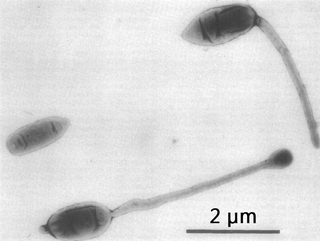Rubrobacter is a genus of Actinomycetota. It is radiotolerant and may rival Deinococcus radiodurans in this regard.
The Halanaerobiales are an order of bacteria placed within the class Clostridia, and encompassing two families, the Halanaerobiaceae and the Halobacteroidaceae. Originally placed within the highly polyphyletic class Clostridia, according to the NCBI and LPSN, it is now thought to lie outside the Bacillota. Halanaerobiales are halophilic obligate anaerobes with a fermentative or homoacetogenic metabolism.
Pedomicrobium is a ubiquitous bacterium dominant in biofilms of man-made aquatic environments such as water distribution systems and bioreactors. Due to their abilities to oxidise manganese (Mn), they are found to be the main culprits of Mn related “dirty water”.
Dichloromethane dehalogenase (EC 4.5.1.3; systematic name dichloromethane chloride-lyase (adding H2O; chloride-hydrolysing; formaldehyde-forming)) is a lyase enzyme that generates formaldehyde.
In taxonomy, Hyphomonas is a genus of the Hyphomonadaceae.
Dimethyl-sulfide monooxygenase (EC 1.14.13.131, dimethylsulfide monooxygenase) is an enzyme with systematic name dimethyl sulfide,NADH:oxygen oxidoreductase. This enzyme catalyses the following chemical reaction

Hyphomicrobium is a genus of Gram-negative, non-spore-forming, rod-shaped bacteria from the family of Hyphomicrobiaceae. It has a large polar or sub-polar filiform prostheca very similar to that of Caulobacter. In addition to having a nutritional function, the prostheca also plays a role in the initiation of DNA replication.
Hyphomicrobium aestuarii is a Gram-negative bacteria from the genus of Hyphomicrobium.
Hyphomicrobium chloromethanicum is an aerobic, methylotrophic bacteria from the genus of Hyphomicrobium which can utilize chloromethane as the only source of carbon.
Hyphomicrobium denitrificans is a bacterium from the genus of Hyphomicrobium which was isolated from the Netherlands.
Hyphomicrobium facile is a bacterium from the genus of Hyphomicrobium which was isolated from soil in New Hampshire in the United States.
Hyphomicrobium hollandicum is an aerobic bacteria from the genus of Hyphomicrobium which was isolated from soil in California in the US.
Hyphomicrobium methylovorum is a bacterium from the genus of Hyphomicrobium which was isolated from soil samples in Japan.
Hyphomicrobium nitrativorans is a bacterium from the genus of Hyphomicrobium which was isolated from biofilm at the Montreal Biodome in Canada.
Hyphomicrobium sulfonivorans is a bacterium from the genus of Hyphomicrobium which was isolated from garden soil in Warwickshire in England.
Hyphomicrobium vulgare is a bacterium from the genus of Hyphomicrobium.
Hyphomicrobium zavarzinii is a bacterium from the genus of Hyphomicrobium which was isolated from swampy soil in Moscow in Russia
Rubrobacteria is a class of Actinomycetota. The currently accepted taxonomy is based on the List of Prokaryotic names with Standing in Nomenclature (LPSN) and National Center for Biotechnology Information (NCBI).
Ann Patricia Wood is a retired British biochemist and bacteriologist who specialized in the ecology, taxonomy and physiology of sulfur-oxidizing chemolithoautotrophic bacteria and how methylotrophic bacteria play a role in the degradation of odour causing compounds in the human mouth, vagina and skin. The bacterial genus Annwoodia was named to honor her contributions to microbial research in 2017.
